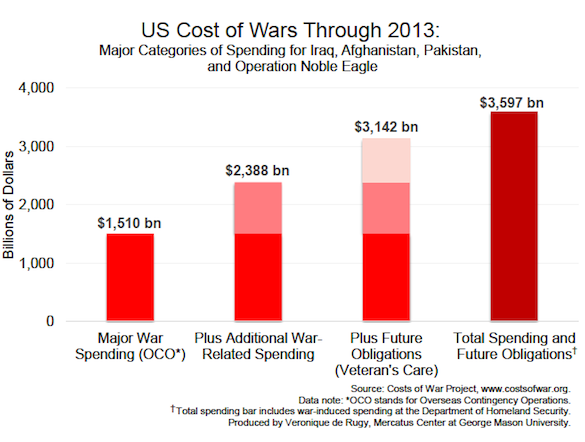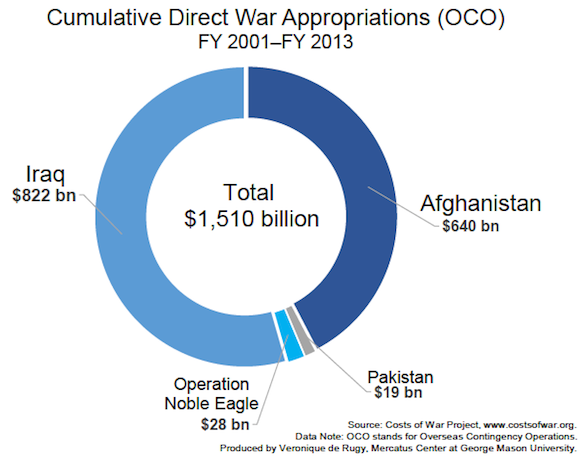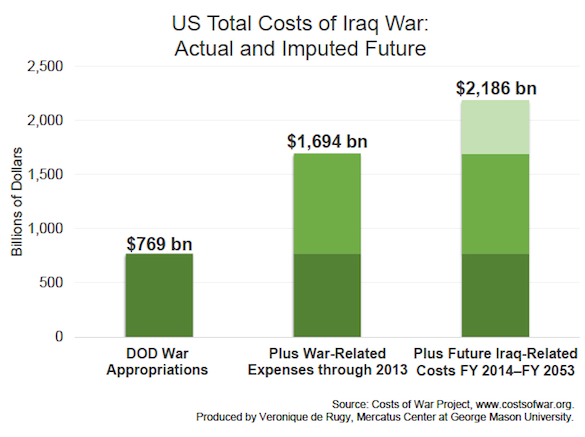- | Government Spending Government Spending
- | Data Visualizations Data Visualizations
- |
The Budgetary Impact of Recent US Wars
Wars are always more expensive than officials and lawmakers promise. It is important to ask what any intervention by the United States in Syria would cost and how the bills would be paid.
Wars are always more expensive than officials and lawmakers promise. It is important to ask what any intervention by the United States in Syria would cost and how the bills would be paid.
This chart series uses data from a March 2013 report by the Costs of War Project of dollar estimates of the US wars since 2001. These dollar estimates take into account additional war-related spending over and above the base budget and future obligations to veterans, along with borrowing costs.
Chart 1. Summary Overview of Major Categories of War Spending in Billions
From FY 2001–2013, the United States has spent and taken on obligations to spend in excess of $3.1 trillion on the wars in Iraq, Afghanistan, and Pakistan. The additional war-related spending includes both increases to the DOD base budget (roughly $780 billion) and benefits for veterans (medical, disability, and social security payments, coming to roughly $134 billion). The total costs are higher still when war-induced spending at the Department of Homeland Security and interest due on borrowing to pay for the wars are added to the total.
Chart 2. Cumulative Direct War Appropriations
Although the duration of the Iraq War was shorter than the war in Afghanistan, it was comparatively more expensive. As of March 2013, the war in Iraq had cost more than $822 billion in special direct war appropriations to the DOD, the State Department, and USAID. The Iraq War accounted for 54 percent of total direct war funding, while 42 percent went to the war in Afghanistan, and about 3 percent for Pakistan and military operations related to homeland security and support to federal, state, and local agencies in the wake of the 9/11 attacks, also known as Operation Noble Eagle (ONE).
The cost of intervention is unclear because there are so many factors to consider. The most obvious is mission creep, when intervention becomes deeper than originally planned, which could send bills soaring. There are additional appropriations for war, over and above the general and continuing funding for DOD or base budget, and appropriations for other war-related activities in budgets of the State Department and Veteran’s Administration. To give us a clear example from the recent past, the chart below breaks down these additional costs for the Iraq War.
Chart 3. Breakdown of Additional War Spending and Future Obligations for Iraq War
As Seth Cline of U.S. News and World Report pointed out earlier this year, “the Bush administration estimated the [Iraq] war would cost $50 to $60 billion, including the costs of reconstruction and clean up. As of 2013, the Cost of War Project estimates the war has cost $1.7 trillion—nearly 30 times the pre-war estimate.”
The Obama administration and the Congressional Budget Office haven’t scored the cost of the Syrian intervention, yet but when they do, taxpayers should take the numbers with a grain of salt. Wars always cost more than projected. In any case, the cost of the intervention, whether small or large, shouldn’t simply be added to the nation’s credit card.
In any case, the cost of the intervention, whether small or large, shouldn’t simply be added to the nation’s rapidly growing debt of $ 16.7 trillion, which current spending levels are expected to expand by $5.7 trillion by 2023, even without a new war.
Veronique de Rugy expounds on the costs of US intervention in Syria in the Washington Examiner.





